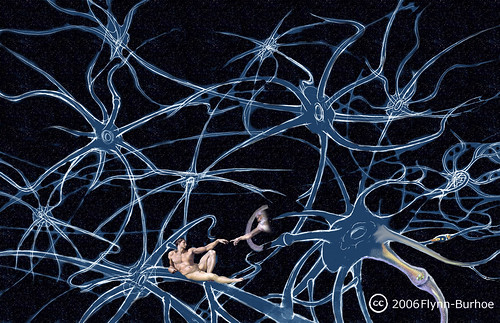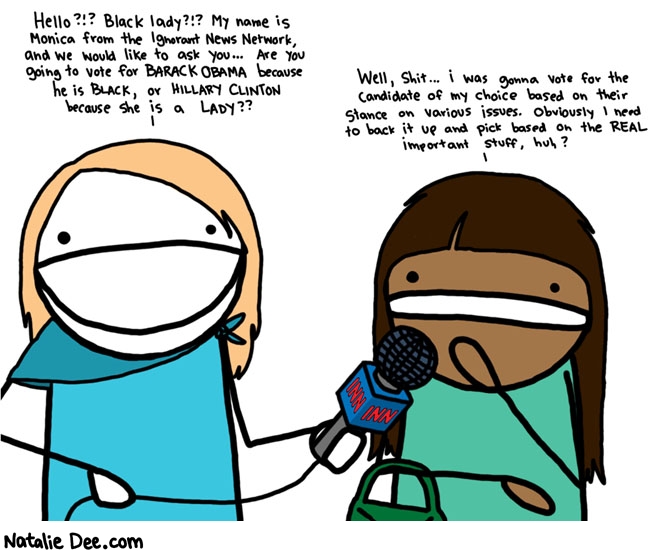Saturday, March 31, 2018
Feeling and Imagination Is No Match For Thinking and Working
By
CNu
at
March 31, 2018
0
comments
![]()
Labels: addiction , as above-so below , celebrity , dopamine , hegemony , identity politics , not a good look , po thang... , status-seeking , Toxic Culture?
Black Panther: Keeping Negroes Broke But Feeling Fabulous
By
CNu
at
March 31, 2018
0
comments
![]()
Labels: addiction , as above-so below , celebrity , dopamine , hegemony , identity politics , not a good look , po thang... , status-seeking , Toxic Culture?
Friday, March 30, 2018
When Feeling Fabulous Seems More Important Than Your Fixed Position...,
By
CNu
at
March 30, 2018
0
comments
![]()
Labels: addiction , as above-so below , celebrity , dopamine , hegemony , identity politics , not a good look , po thang... , status-seeking , Toxic Culture?
Negroes in Drag...,
By
CNu
at
March 30, 2018
0
comments
![]()
Labels: addiction , as above-so below , celebrity , dopamine , hegemony , identity politics , not a good look , po thang... , status-seeking , Toxic Culture?
Monday, January 15, 2018
Friday, January 12, 2018
Decision Neuroscience (REDUX Originally Posted 11/24/08)
 This will not be the first time you've heard this from me, I've variously addressed it hereabouts under the rubrics neuroeconomics or dopamine hegemony - but this morning my very good friend Arnach hit me up back channel with a morsel supportive of the theory that global human governance boils down to the science of stimulating and controlling dopaminergy in the individual brain.
This will not be the first time you've heard this from me, I've variously addressed it hereabouts under the rubrics neuroeconomics or dopamine hegemony - but this morning my very good friend Arnach hit me up back channel with a morsel supportive of the theory that global human governance boils down to the science of stimulating and controlling dopaminergy in the individual brain. From the Stanford Storybank we have This is Your Brain on Bargains.
From the Stanford Storybank we have This is Your Brain on Bargains. Scientific inspiration can derive from the most mundane experience. Archimedes was said to have figured out how to compute volume in his bathtub. When Uzma Khan had her eureka moment, she was sprawled on her couch, just back from a shopping mall where she had gone to avoid working on her dissertation.So simple, elegant, and obvious. Selective governance via the natural tendency of the brain's neuronal circuits to Do What They Do..., what could be easier, more powerful, and more durable than that? The basic fact is that humans are routinely exploited by those with the wherewithal to "engineer" values in the outside world and a little knowledge of the workings of the "inside" world. - This takes us then to the meatus of the economic beatus - which isn't quantum mechanics - but a depth psychology informed by an expansive understanding fractal unfolding and the poised realm what that knowledge is and where exactly it came from.
Khan—then at Yale, now an assistant professor of marketing at the Graduate School of Business—knew all about the supposed levers of consumer behavior: supply, demand, advertising, discounting. Traditionally, business theorists described consumer behavior as being based on rational decisions about value and price. But as Khan looked at the shopping bags strewn around her apartment she realized that the conventional wisdom was, well, bankrupt. She was sure that her buying decisions had much less to do with price than they did her frayed nerves. She had gone shopping to feel better. Once home, the thrill was gone. “I looked at all that stuff, all those bags, and I thought, 'I don't need this stuff. I'm going to take most of it back. What was I thinking?'”
Khan's professional focus today is answering that question—what are we thinking when we go shopping? She is one of a growing number of researchers at Stanford and elsewhere working on consumer mysteries: Why are our needs and wants so disconnected? Why do people dig themselves into debt from foolish spending? Why do our brains perceive expensive products as superior? And what are the biological bases for the pleasures that shopping or even the anticipation of shopping can unleash?
By
CNu
at
January 12, 2018
0
comments
![]()
Labels: addiction , alkahest , azoth , banksterism , cognitive error , dopamine , governance , hegemony , hypnosis , What IT DO Shawty...
Neuroeconomics: Dopaminergy In The Individual Brain (REDUX Originally Posted 01/26/08)
 A couple months ago, I introduced the concept of neuroeconomics in the context of collective psychology. It's time to take that a step further - a la the philosopher Daniel Dennett, channeling the late ATL Gurdjieffian prankster Jan Cox.
A couple months ago, I introduced the concept of neuroeconomics in the context of collective psychology. It's time to take that a step further - a la the philosopher Daniel Dennett, channeling the late ATL Gurdjieffian prankster Jan Cox.From that earlier article I stated that "For decades it has been known that these neurons and the dopamine they release play a critical role in brain mechanisms of reinforcement. Many of the drugs currently abused in our society mimic the actions of dopamine in the brain. This led many researchers to believe that dopamine neurons directly encoded the rewarding value of events in the outside world."Several people have sent me notes about their problems and apparent failures, and have attempted to attribute a psychological basis to them. This is one of the great cutoff points. It is an immediate slap in the intellectual face: to a Revolutionist there is no such thing as "psychological." It is a flawed piece of data. It is as outmoded to a Revolutionist alive today as is the idea of a "capital-g" god. What is called "psychological" is serving, and has served, a purpose with some people. But you must see that any apparent psychological pressures arising from influences apparently "out there" -- your boss, your mother, your mate -- have to enter in through the five senses. Always stop and remind yourself of that even if you can't do anything else. If one or all of your senses were knocked out, you would not be suffering this "psychological pressure." You have to face up to that. Whatever is going on in you is chemical. There are really no such things as drunks; it is people with an alcohol deficiency. Absolutely religious people have a chemical deficiency. The same with people who have phobias, as they are called. It is a chemical imbalance outside the normal bell curve of the populace at their time and place. Jan Cox
Today's post is one of those hidden in plain sight elaborations on that theme, this time addressing the rewarding value of events in the INSIDE WORLD, the world comprised of the neurons making up your brain. Think about it. That's all I ever ask you to do, and in the process, you will inevitably be led to draw your own validating conclusions. Here's Dennett;
brain cells — I now think — must compete vigorously in a marketplace. For what?So simple, elegant, and obvious. Selective governance via the natural tendency of the brain's neuronal circuits to Do What They Do..., what could be easier, more powerful, and more durable than that. The lengths to which some folks will go to furnish elaborate post hoc rationalizations of What It Do - and how that basic fact is exploited by those with the wherewithal to "engineer" values in the outside world - just crack me up.
What could a neuron "want"? The energy and raw materials it needs to thrive–just like its unicellular eukaryote ancestors and more distant cousins, the bacteria and archaea. Neurons are robots; they are certainly not conscious in any rich sense–remember, they are eukaryotic cells, akin to yeast cells or fungi. If individual neurons are conscious then so is athlete’s foot. But neurons are, like these mindless but intentional cousins, highly competent agents in a life-or-death struggle, not in the environment between your toes, but in the demanding environment of the brain, where the victories go to those cells that can network more effectively, contribute to more influential trends at the virtual machine levels where large-scale human purposes and urges are discernible.
I now think, then, that the opponent-process dynamics of emotions, and the roles they play in controlling our minds, is underpinned by an "economy" of neurochemistry that harnesses the competitive talents of individual neurons. (Note that the idea is that neurons are still good team players within the larger economy, unlike the more radically selfish cancer cells. Recalling Francois Jacob’s dictum that the dream of every cell is to become two cells, neurons vie to stay active and to be influential, but do not dream of multiplying.)
Intelligent control of an animal’s behavior is still a computational process, but the neurons are "selfish neurons," as Sebastian Seung has said, striving to maximize their intake of the different currencies of reward we have found in the brain. And what do neurons "buy" with their dopamine, their serotonin or oxytocin, etc.? Greater influence in the networks in which they participate.
By
CNu
at
January 12, 2018
0
comments
![]()
Labels: addiction , alkahest , azoth , banksterism , cognitive error , dopamine , governance , hegemony , hypnosis , What IT DO Shawty...
Neuroeconomics - Dopamine Hegemony (REDUX Originally Posted 12/02/07)

For decades it has been known that these neurons and the dopamine they release play a critical role in brain mechanisms of reinforcement. Many of the drugs currently abused in our society mimic the actions of dopamine in the brain. This led many researchers to believe that dopamine neurons directly encoded the rewarding value of events in the outside world.
- "an emerging transdisciplinary field that uses neuroscientific measurement techniques to identify the neural substrates associated with economic decisions” (Zak, 2004, p. 1737)
- “Economics, psychology and neuroscience are converging today in to a single unified discipline with the ultimate aim of providing a single, general theory of human behavior. (…) The goal of this discipline is thus to understand the processes that connect sensation and action by revealing the neurobiological mechanisms by which decisions are made". (Glimcher & Rustichini, 2004, p. 447)
- “the program for understanding the neural basis of the behavioral response to scarcity” (Ross, 2005, p. 330)
By
CNu
at
January 12, 2018
0
comments
![]()
Labels: addiction , alkahest , azoth , banksterism , cognitive error , dopamine , governance , hegemony , hypnosis , What IT DO Shawty...
Wednesday, January 10, 2018
Money As Tool, Money As Drug: The Biological Psychology of a Strong Incentive
By
CNu
at
January 10, 2018
0
comments
![]()
Labels: addiction , banksterism , debt slavery , dopamine , hegemony , human experimentation , hypnosis , transbiological , tricknology , What IT DO Shawty...
Tuesday, January 09, 2018
Pure Identity Politics (REDUX Originally Posted 8/30/08)
 Three and a half years ago, I anticipated and wrote about what's now unfolding in the presidential election. Over the next few weeks, there'll be a lot of mendacious talk about everything on the periphery of what just happened. But let me spell out the truth of the matter very simply and directly here and now.
Three and a half years ago, I anticipated and wrote about what's now unfolding in the presidential election. Over the next few weeks, there'll be a lot of mendacious talk about everything on the periphery of what just happened. But let me spell out the truth of the matter very simply and directly here and now.
By
CNu
at
January 09, 2018
0
comments
![]()
Labels: addiction , American Original , Ass Clownery , Cathedral , celebrity , corporatism , de-evolution , doesn't end well , feminization , identity politics , Peak Negro , shameless
Friday, November 17, 2017
Franken-Furter: #YouToo? Troglodytes Eating One Another Alive
Al Franken: There was not as much cocaine as you would think on the premises. Yeah, a number of people got in trouble. But cocaine was used mainly just to stay up.
There was a very undisicplined way of writing the show, which was staying up all night on Tuesday. We didn't have the kind of hours that normal people have. And so there was a lot of waiting until Tuesday night, and then going all night, and at two or three or four in the morning, doing some coke to stay up, as opposed to doing a whole bunch, and doing nitrous oxide, and laughing at stuff.
People used to ask me about this and I'd always say, "No, there was no coke. It's impossible to do the kind of show we were doing and do drugs." And that was just a funny lie that I liked to tell. Kind of the opposite was true, unfortunately, for some people, it was impossible to do the show without the drugs.
By
CNu
at
November 17, 2017
0
comments
![]()
Labels: #YouToo? , addiction , celebrity , Collapse Casualties , comedy gold , Degenerate , professional and managerial frauds , reality casualties , unintended consequences
Monday, November 06, 2017
Ruthless Marketing - Billions of Dollars, Millions of Addicts...,
By
CNu
at
November 06, 2017
0
comments
![]()
Labels: addiction , American Original , Left Behind , Pimphand Strong , Rule of Law , What Now?
The Opioid Crisis in America...,
By
CNu
at
November 06, 2017
0
comments
![]()
Labels: addiction , American Original , Left Behind , musical chairs , What Now?
Thursday, October 12, 2017
Culture of Compliance: Every Single One of These Peasants Deserves to be a Slave...,
By
CNu
at
October 12, 2017
0
comments
![]()
Labels: addiction , celebrity , Degenerate , peasants , Pimphand Strong , play-at-your-level , status-seeking , stay-in-your-lane
Tuesday, October 10, 2017
Black Identity Extremist Stripper Blows Up Miami Dolphins Offensive Line...,
By
CNu
at
October 10, 2017
0
comments
![]()
Labels: A Kneegrow Said It , addiction , bad apples , comedy gold , Degenerate , doesn't end well , domestic terrorism , not a good look , you used to be the man
Sunday, October 08, 2017
Smartphone Dystopia
By
CNu
at
October 08, 2017
0
comments
![]()
Labels: addiction , cognitive infiltration , tricknology , unintended consequences
Thursday, September 07, 2017
Michelle Obama On the Front Line for Po Black Folks...,
By
CNu
at
September 07, 2017
0
comments
![]()
Labels: addiction , Ass Clownery , celebrity , global system of 1% supremacy , Obamamandian Imperative , Peak Negro , Toxic Culture?
Monday, September 04, 2017
Banksters Not About To Surrender Their Drug Money Laundering Profits...,
Fighting drug trafficking was one of the main reasons the Uruguayan government gave for legalizing recreational marijuana. Officials spent years developing a complex regulatory framework that permits people to grow a limited supply of cannabis themselves or buy it at pharmacies for less than the black market rate. Lawmakers hoped that these legal structures would undercut illicit marijuana cultivation and sales.
“There probably isn’t a trade in Uruguay today that is more controlled than cannabis sale,” said Pablo Durán (a legal expert at the Center of Pharmacies in Uruguay, a trade group).
By
CNu
at
September 04, 2017
0
comments
![]()
Labels: addiction , banksterism , narcoterror , Vampire Squid , What IT DO Shawty...
Tuesday, August 29, 2017
Subverting Marijuana Legalization While Facilitating Heroin Exfiltration...,
By
CNu
at
August 29, 2017
0
comments
![]()
Labels: .45 , addiction , Deep State , Degenerate , narcoterror , necropolitics , predatory militarism , professional and managerial frauds , The Great Game
With Intersectional "Allies" Like Ed Buck, Who Needs Nazi's for Enemies?
By
CNu
at
August 29, 2017
0
comments
![]()
Labels: addiction , Cathedral , cephalopod mollusc , Degenerate , identity politics , Livestock Management , necropolitics , niggerization , parasitic , professional and managerial frauds , Race and Ethnicity
DEI Is Dumbasses With No Idea That They're Dumb
Tucker Carlson about Alexandria Ocasio-Cortez and Karine Jean-Pierre: "The marriage of ineptitude and high self-esteem is really the ma...
-
theatlantic | The Ku Klux Klan, Ronald Reagan, and, for most of its history, the NRA all worked to control guns. The Founding Fathers...
-
Video - John Marco Allegro in an interview with Van Kooten & De Bie. TSMATC | Describing the growth of the mushroom ( boletos), P...
-
Farmer Scrub | We've just completed one full year of weighing and recording everything we harvest from the yard. I've uploaded a s...

